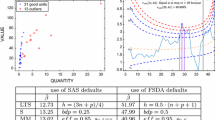Abstract
Comments on the “monitoring” method and its relationships with other robust estimation methods.
Similar content being viewed by others
References
Cerioli A, Riani M, Atkinson AC, Corbellini A (2018) The power of monitoring: how to make the most of a contaminated multivariate sample, Stat Methods Appl (in press)
Maronna RA, Yohai VJ (2014) High finite-sample efficiency and robustness based on distance-constrained maximum likelihood. Comput Stat Data Anal 83:262–274
Maronna RA, Yohai VJ (2017) Robust and efficient estimation of high dimensional scatter and location. Comput Stat Data Anal 109:64–75
Smucler E, Yohai VJ (2017) Robust and sparse estimators for linear regression models. Comput Stat Data Anal 111:116–130
Author information
Authors and Affiliations
Corresponding author
Rights and permissions
About this article
Cite this article
Maronna, R.A., Yohai, V.J. Discussion of “The power of monitoring: how to make the most of a contaminated multivariate sample” by Andrea Cerioli, Marco Riani, Anthony C. Atkinson and Aldo Corbellini. Stat Methods Appl 27, 603–604 (2018). https://doi.org/10.1007/s10260-017-0414-y
Accepted:
Published:
Issue Date:
DOI: https://doi.org/10.1007/s10260-017-0414-y




